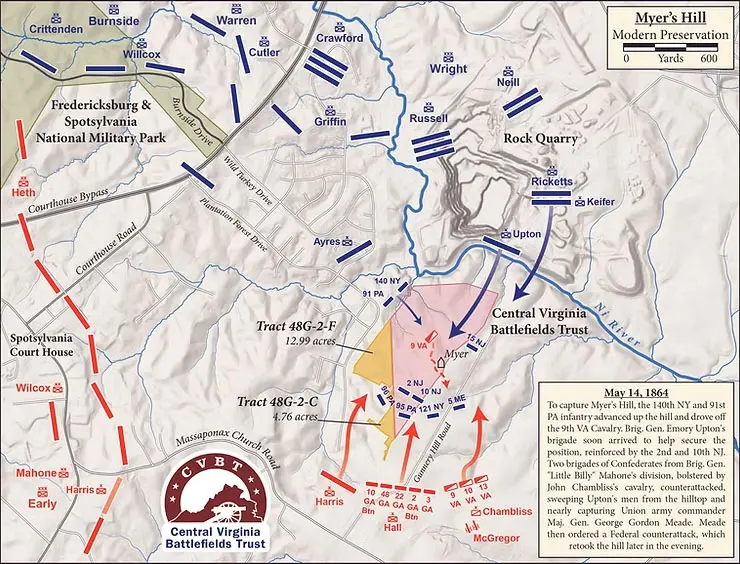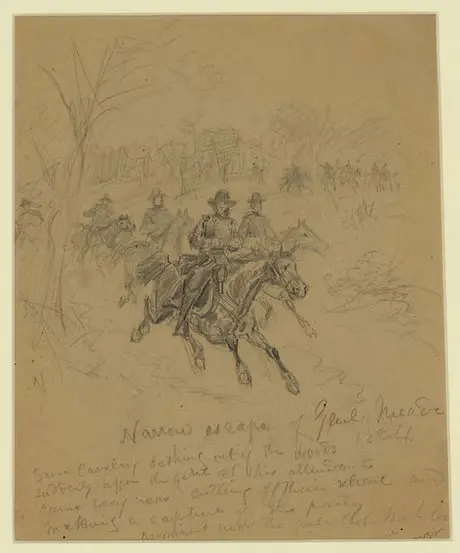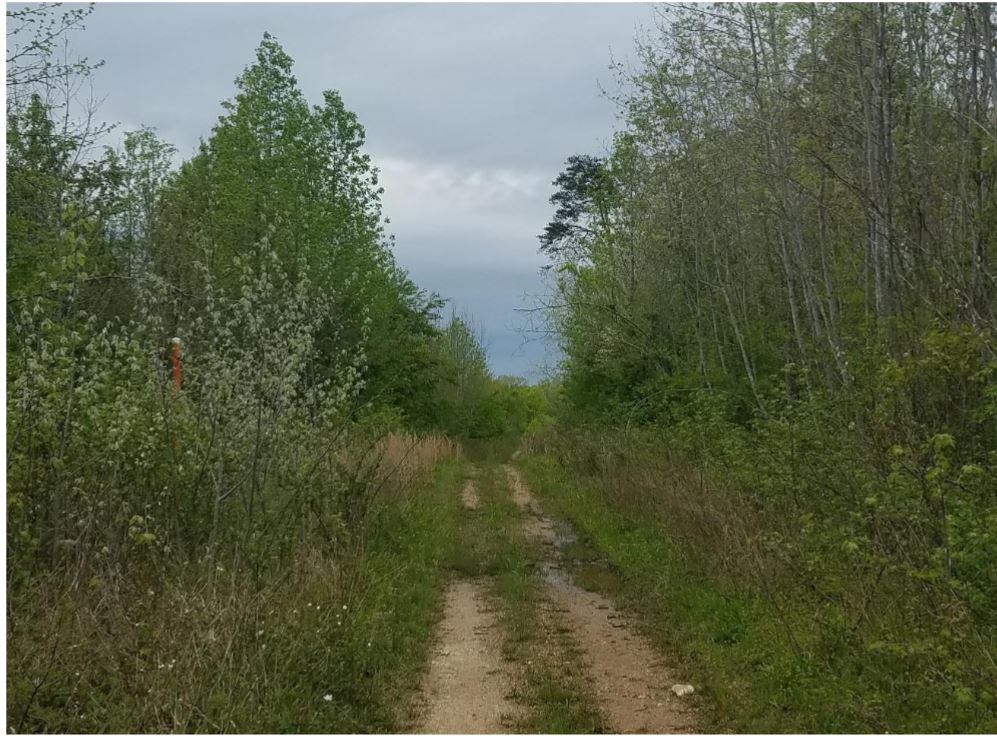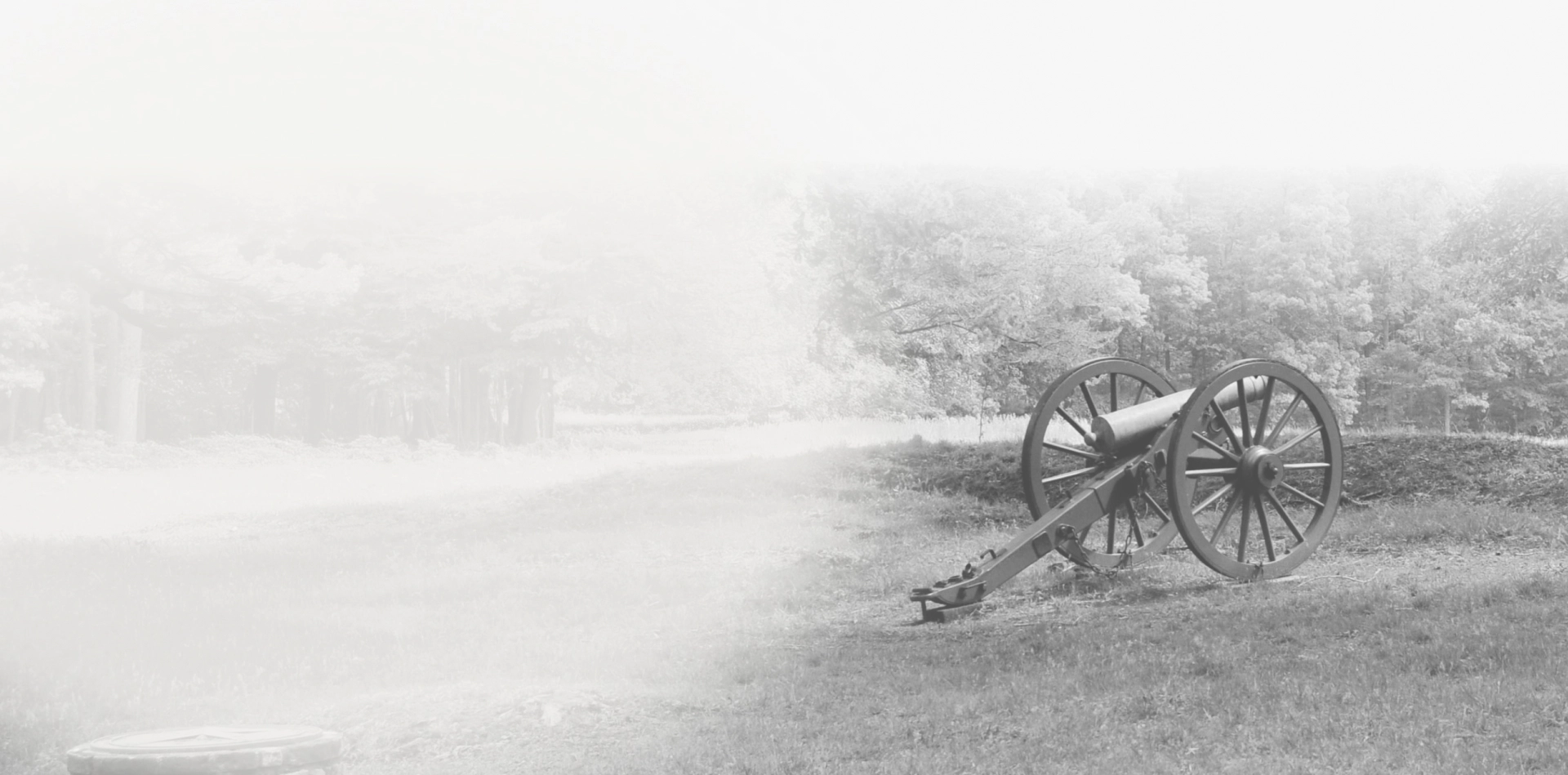

While the 1864 battle of Spotsylvania Court House is best known for the May 12 fighting at the “Bloody Angle,” there was more to the battle than just the Mule Shoe Salient.
In 2018, Central Virginia Battlefields Trust began the acquisition of a vitally important piece of property that will open up more of the story of the battle of Spotsylvania Court House. This important property is Myer’s Hill.
“Myer’s Hill is one of the most important pristine sites remaining to be preserved on the Spotsylvania Court House battlefield,” says award-winning historian Gordon Rhea, whose work has focused on the 1864 Overland Campaign, including Spotsylvania Court House. “It is imperative that this key location be saved to enable future generations to walk the ground and understand the momentous events that transpired there.”
“The story of the second week of fighting at Spotsylvania Court House often gets overlooked in favor of the dramatic story at the Mule Shoe Salient, but there is a tremendous amount we can learn from that second week,” explains historian Chris Mackowski, who has written extensively about the battle of Spotsylvania Court House. “The acquisition of Myer’s Hill will open up that broader story, so people can more fully understand the battle and the commanders.”
The May 14, 1864, fighting for Myer’s Hill pitted Union Brigadier General Emory Upton, a bold “young Turk” fresh off an innovative attack against the Mule Shoe on May 10, against one of the most irascible, hard-fighting generals in the Confederate army, Robert E. Lee’s “Bad Old Man,” Maj. Gen. Jubal Early.
“Federals hoped to outflank Lee on Lee’s right, so they shifted half the army for a major attack in the Myer’s Hill sector of the battlefield, but muddy roads worked against them,” Mackowski says. “Confederate artillery on Myer’s Hill threatened the new Union position, so Meade gave permission for his men to take it.”
First up the hill were two Fifth Corps regiments, the 140th New York and the 91st Pennsylvania infantry—two Zouave units wearing brightly colored uniforms patterned after the French foreign legion. They drove away Confederate cavalrymen from the 9th Virginia Cavalry, which consisted of horsemen raised from the local area. Independently, Upton led 800 men on a charge to take the hill but found it occupied by the Zouaves by the time he reached the summit. He deployed his men in a defensive position to further secure it.
“Lee still wasn’t sure what the Federals were up to by this point, so he ordered Early to retake the hill,” Mackowski says. “In the meantime, Meade rode to the hilltop to see the situation for himself. In the ensuing fight, Confederate cavalry nearly captured Meade, who only barely escaped.”
Angry, Meade ordered the hill re-taken. This time, four brigades swept forward, but by that time, Lee had better determined Federal intentions and withdrew Early’s men to a more secure position. Federals retook the hill and occupied it for the remainder of the battle, which lasted through May 21.
“Spotsylvania is one of the seismic battles of the Civil War,” says legendary historian Ed Bearss, former chief historian for the National Park Service. “At Myer’s Hill Grant was checked, but he goes back and takes it. The fighting for the hill results in a crucial two-day delay for his army.


“The Myer’s Hill Battlefield is quite noteworthy among preservation sites”, stated local historian John Cummings. ” Its story covers not only a military action, but also a poignant tale of Fredericksburg war refugees, who, like Wilmer McClean of Manassas to Appomattox fame, couldn’t keep clear of the fighting. Additionally, it features an amazing moment of peril to the commander of the Army of the Potomac, as well as the sad capture of numerous Union soldiers and the tragic death of one of their Lieutenant Colonels”.
I”t is capped off by the destruction of the property caused by the poor judgment of its civilian caretaker, while the conscripted owner endured battle less than two miles from his beleaguered home. It is the site of near disaster, and tragedies all around. John Henry Myer had sought to distance his family from the horrors of war by moving them to his newly acquired farm, nine miles as the crow flies, to the southwest of ravaged Fredericksburg. The tranquility they sought lasted only a year, as the Spring Campaign of 1864 descended on the area of Spotsylvania Court House.”
Myer’s Hill counts as one of CVBT’s larger preservation efforts in the twenty-two years we have been saving our history. At a cost of $460,000 we were able to pay off this property quickly with matching grants and the help of our faithful members and donors.
More Myer’s Hill Land Saved!
In 2021 Rappahannock Plantation, LLC, has made a generous donation of approximately 17.75 acres of the Myer’s Hill Battlefield, along and within the Woodbury Manor subdivision. The hallowed ground will also provide an important access and future interpretation point for the battlefield preservation. This generous gift brings the total preserved land at Myer’s Hill to a little over 91 acres. Special thanks goes to Sean Haynes, the owner and manager of the company, and Chris Hornung, the engineer who works for Sean as part of his other company, Rappahannock Development Group, LLC, and CVBT Board member John McManus for facilitating this gift that adds to the understanding of what happened at the lesser-known Battle of Myer’s Hill.
Aside from the new property’s historical value, it has incredible value to CVBT because our previous holdings of 73 acres at Myer’s Hill were effectively landlocked, but this new donation gives us an easy public access point to the property. According to CVBT President Tom Van Winkle, “Months of work have been rewarded by making the best of our resources and finding exceptional individuals and companies willing to work with CVBT.”

NEWSLETTER SIGN-UP
Join our community! Sign up for our newsletter to receive exclusive updates, event information, and preservation news directly to your inbox.